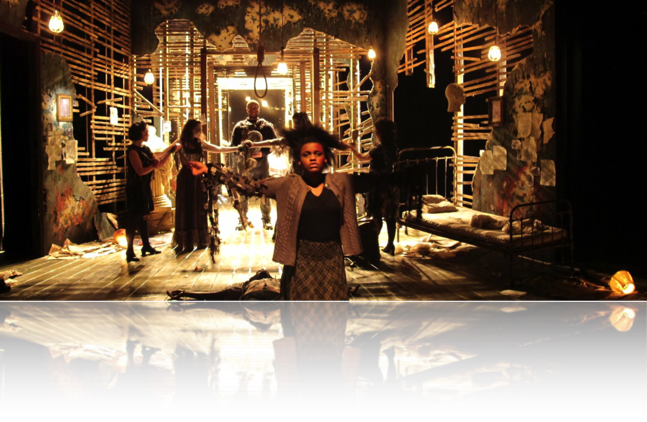
Brandeis Theater CompanySpring 2010
Directed by David Gammons
Scene Design by Carlos Aguilar
Lighting Design by Benjamin Williams
Costume Design by Elisabetta Polito
Music and Sound Design by David Wilson
Funnyhouse of a Negro
First produced in 1964 at the urging of her mentor Edward Albee, Adrianne Kennedy's Funnyhouse of Negro is an extended hallucination suffered by Sarah, an acute schizophrenic on a downward spiral to suicide. Her multiple personalities were brought on by physical and emotional abuse, and in the larger sense, by history and society - colonization, racism, sexism, classism, and all the elements that block her from being whole, from being her one self. Her four personalities reflect these conflicts: Queen Victoria, the Duchess of Hapsburg, Patrice Lumumba, and Jesus, a hunchbacked yellow skinned dwarf. In addition to her selves, Raymond, her white Jewish lover, Sarah's Landlady, and The Mother round out the occupants of this Funnyhouse.
The setting for this production was a now-abandoned building where Sarah lived and died. Ribs of lath and rafters form the skeleton that encases the remains of Sarah's apartment, a noose hangs from above. A wall of plastic sheeting hangs across the front, shadows and sounds of past and present play out as the audience enters. The rustle of pigeons, a raven, knocking and escaping steam from a radiator, dripping, creaking, rustling, and the slow twisting of a rope under stress. At opening the shadow of Sarah in the noose is revealed, the selves enter and tear the sheets down, we enter the world Sarah has created.
Aural images were derived from explicit and implicit dialogue and stage direction, the historical personas of her selves and associated events, symptoms of schizophrenia and associated mental illness, and an imagined back story of Sarah and her lover. Sarah is the daughter of a white woman and a black father. Her selves range from the porcelain white of Queen Victoria, to the yellow skinned Jesus, to the ebony Lumumba. Sarah attended college, an English major and bibliophile, aspired to write poetry in the style of Edith Sitwell, claims her father raped her mother. She says her boyfriend, the Funnyman, is "interested in Negros," perhaps more of an intellectual or cultural interest rather than romantic. Her mother roams the stage dressed in a white nightgown, carrying a bald head.
Elements of the Sound Design
Constructed sampler instruments:
Poetry Machine:
Words and phrases of Edith Sitwell reciting her works, along with musical compositions utilizing her poems, composed by George Crumb, Benjamin Britten, and William Walton, phrases of vocalise from period art songs. This instrument was used to create the impression of the "word salad" that schizophrenics experience - aural hallucinations of words and phrases, based on the material she studied and embraced, and yearned to emulate. Perhaps this intense study and immersion in Anglo culture led to her final break.
Steam Cello:
Mixture of bowed cello and escaping steam, formed the ground upon which other sound elements played over. Based on another aural hallucination of hearing a sound (i.e. escaping steam of a radiator) and perceiving it as something else. Various incarnations of the steam sound were used to simulate slow breathing (of her father, the wild black beast), and the snake in the jungle that rises up around her.
Distressed Piano:
Multiple layers of distressed upright pianos, prepared piano, toy piano and other effects.
Piano Effects:
Knocking on piano lid with endless sustain (the knocking called for in the script) , rubbing and striking strings, ambient sustained note clusters.
Elastic Quintet:
Brass instruments pulled like taffy, elongated, labored, lethargic, decayed and distressed. Underscored entrance and movement of Queen Victoria and Duchess of Hapsburg with Handel's Sarabande using these instruments with Distressed Piano.
Other elements:
Raymond: imagined as a Jazzophile - free Jazz from Ornette Coleman and Sun Ra
Sudden turns: Scenes change in an instant to mad explosions of sound and light and convulsive movement, a bald head drops from above - Lou Christie's pop gem "Two Faces Have I," James Darren's circus-like "Goodbye Cruel World," Kitty Wells' Kitschy "How Far is Heaven?"
Patrice Lumumba's Uhuru (freedom) speech in Swahili amidst static and dropouts underscores his monologue and ends in assassination.
Applause and audience sound - Sarah as the observed, on display, naked.
All music © David Wilson 2006-2016 All Rights Reserved